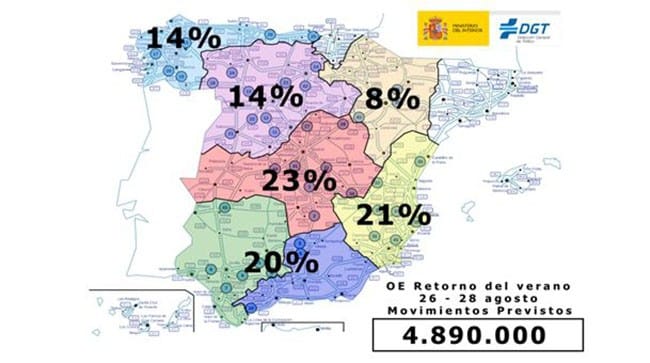On Friday, at 3:00 p.m., the last of the special operations that the General Directorate of Traffic organise for this summer begins, which will see the generalised return of tourists from coastal and mountainous regions to the cities throughout the weekend.
It is anticipated that there will be a total of 4,890,000 long-haul movements in the special operation will remain active until midnight on Sunday, August 28.
During the next few days, the usual journeys of a summer weekend will coincide on the road, with those of citizens who return to their places of residence after the holidays. These movements will take place especially on Sunday 28, although they will continue to be carried out in stages until the end of the month of August.
Travel forecasts
On Friday 26, between 4 p.m. and 10 p.m., and on Saturday morning, mainly between 9 a.m. and 1 p.m., there will be major long-distance movements that will cause high intensities of traffic that can cause exit retentions of the large cities, as well as on the main access roads to tourist and rest areas, both on the coast and in the mountains. By late Friday evening the problems can be localised to the target areas.
To these movements, of those who now start their vacations, will be added the usual departures at the beginning of the summer weekend towards the coastal areas and second homes.
In addition, on Saturday afternoon it will be possible to observe movements back to the large urban centres of those who end their vacations and make the staggered return to their places of residence, circulatory intensity being able to occur in some road axes.
On Sunday morning, traffic may be conflictive on the roads that connect coastal towns and access to beach areas on short-distance routes, while from the early afternoon (especially between 5 and 11 p.m.). The return will begin, both of those who finish their vacations in August and of those who have gone out to enjoy the weekend, and incidents with high traffic intensity may occur on the main road axes that connect the coastal, mountain or second residence with the accesses to the big cities.
For all this, the DGT recommends as always to plan trips in advance and, if possible, avoid the most unfavourable hours.
Special device
With all this flow of vehicles on the road, the DGT has established a series of measures to regulate, organise and monitor traffic, with the aim of facilitating the mobility and fluidity of the different users of the road and ensuring the safety of all of them, among which stand out:
The installation of additional and reversible lanes with cones at times of greatest traffic flow and on the main access roads to large cities.
The restriction of the circulation of dangerous goods vehicles, special transport and trucks in general and those that transport certain goods in certain sections, dates and times.
The cessation of works on the roads and limitation to the holding of sporting events and other events that involve the occupation of the road.
The design of recommended alternative itineraries according to origin and destination, with distances and travel times and, in some cases, avoiding the downtown area, which is the one with the highest circulatory intensity.
Added to these measures are the human resources available, among which are not only the agents of the Traffic Group of the Guardia Civil, who will ensure the safety of citizens traveling by road, will help drivers who need and will ensure that safe driving is carried out, in accordance with traffic regulations, but also the officials and specialised technical personnel of the DGT that attend to its seven Traffic Management Centres, the helicopter patrols and the more than 13,000 employees of conservation and exploitation companies of the Ministry of Public Works and the rest of the owners of the road, as well as the personnel of the emergency services.
Of course, the special device also has all the material resources available to the General Directorate of Traffic, among which are the 780 fixed speed control radars, of which 92 are sectional, 545 mobile radars that can 12 helicopters and 39 drones, 23 of them with the capacity to denounce, in addition to 245 cameras and 15 camouflaged vans to control the use of mobile phones and seat belts. The DGT also has unmarked vehicles and motorcycles that will circulate on all kinds of roads in order to monitor any infraction.
Driving advice for returning from vacation
Even at the risk of appearing repetitive, the DGT gives drivers a series of recommendations that allow them to make this return home in the best road safety conditions:
Plan the trip along the safest route to avoid unforeseen events. The twitter accounts @informacionDGT and @DGTes or the news bulletins on radio and television, as well as on the 011 telephone, provide information on the traffic situation in real time and any incidents that may exist.
Schedule the most appropriate time for the trip, avoiding the most unfavourable hours and, if necessary, use the proposed alternative itineraries.
Avoid traveling at night or after a tired day at the beach or in the mountains. If the trip lasts more than 8-10 hours, do not do it often.
Avoid copious meals and moderate doses of stimulating drinks, as well as the consumption of those medications that decrease attention or cause drowsiness.
Never drive under the influence of alcohol or drugs or let anyone who has done so get behind the wheel. The only safe rate is 0.0%.
Before starting the trip, check the correct operation of the lights and indicators, as well as the tyre pressure.
Pay attention to driving at all times and respect traffic regulations: speed, safety distance, seat belt for all passengers, etc.





